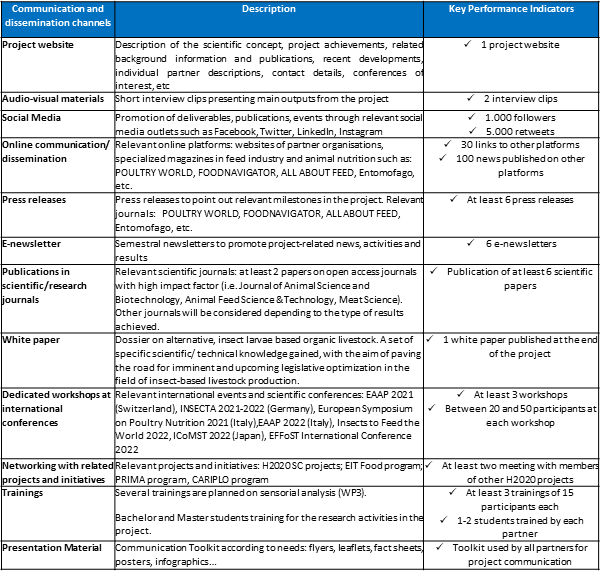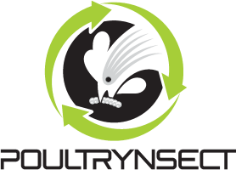C&D Plan
C&D Plan
The work-plan of Poultrynsect includes dissemination of the concept, vision and results of the project. The communication/dissemination plan will define key messages, main project outcomes and outputs, and target audiences. It will select appropriate tools and channels to reach and meet the information needs of the target audiences.
Communication activities
For the external communication strategy, several dedicated activities will be employed to engage with different target audiences.
- In order to better identify the project, a logo will be developed that will be used across all official communication.
- Information about the project objectives, phases and outcomes, consortium partners, etc. will be available to all stakeholders on the project website.
- A leaflet outlining the project will be developed to be distributed by project partners to their own stakeholder groups and networks in the relevant languages.
- Relevant information about Poultrynsect will also be disseminated through the websites, social media channels, newsletters, visiting moments and events of consortium partners.
English will be the main communication language, but specific outreach programs will be adapted to local languages as needed and required. Target groups for dissemination activities include consumers, retailer distributors, feed industries, knowledge and education centres, policy makers, governmental and non-governmental organizations.
Dissemination activities
Central to our dissemination strategy is the plan for the use and dissemination of results outlined below. The dissemination plan details:
- Target audiences: the main targeted audiences are the stakeholders involved in insect production, processing food industry, feed industry and animal nutritionists, policy makers and consumers’ organizations.
- Key messages: will be related to (1) the importance of the ‘multi-stakeholder approach’, (2) the importance of more sustainable protein sources, (3) practical guidance on how stakeholders can implement Poultrynsect results.
- Methods: we will use a wide variety communication tools/channels (including traditional as well as social media) and types of outputs (leaflets, articles, infographics), and the partners networks and communication channels.
- Frequency: In addition to frequent social media presence there will be an e-newsletter dedicated to the major stakeholders with project updates, ad hoc communications linked to events.
Any dissemination activities and publications in the project, including the project website, will (1) specify that the project has received ERA- Net Cofunds SUSFOOD2 and CORE Organic funding and (2) display the SUSFOOD2-CORE Organic emblem. When displayed in association with a logo, the SUSFOOD2-CORE Organic emblem will be given appropriate prominence. All publications shall include the following statement: “The research leading to these results has received funding from the ERA-Net Cofunds SUSFOOD2 and CORE Organic Program for research, technological development and demonstration under grant agreement n° [to define when approved]”.
All publications which originate from the CO/SF projects, will be uploaded and shared via the electronic open-access archive ‘Organic Eprints’: http://orgprints.org/ in order to reach the maximum number stakeholders involved in the organic sector community.
The table below summarizes the main communication and dissemination channels, together their description, used to reach the selected audiences, as well the key performance indicators identified to quantify the impact of these methods.

Capacity Building
As far as the capacity building is concerned, the concrete activities described in the WP5 (Communication & Dissemination) contribute to overall stakeholder engagement and community building and thus ensure broad diffusion of the project’s activities to the relevant societal stakeholders.
Community building activities with relevant stakeholders, also outside project consortium, are implemented to bring together the various actors along the value and supply chain. Interaction among and between the various stakeholders is encouraged to facilitate the build-up of self-sustaining networks and partnerships allowing post-project impact. Community building activities can take place in:
- Events and meetings organized by the project, aiming for effective dissemination but also interactive communication, e.g. Final Conference;
- Participation in relevant events, meetings by project partners;
- Database of relevant stakeholders with an aim to build a self-sustained networks and partnerships for post-project cooperation and impact.
